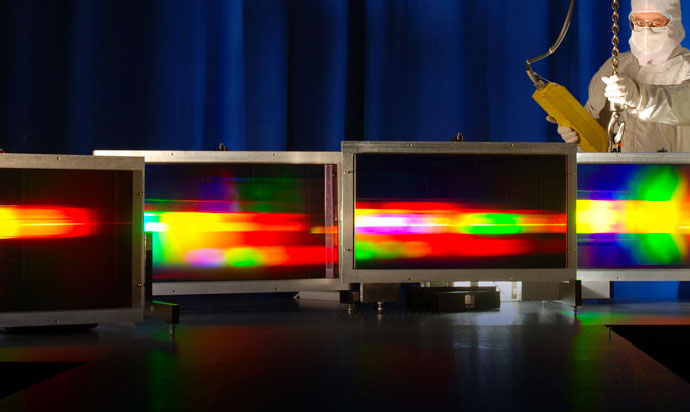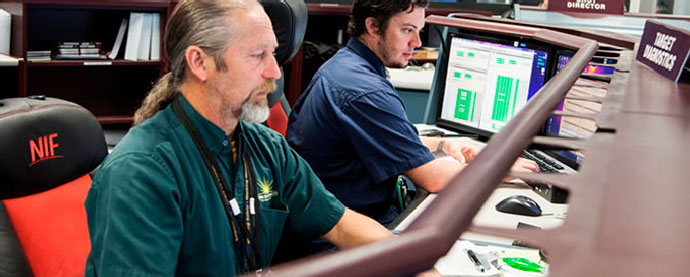Supporting stockpile stewardship through a wide range of nonignition experiments and pursuit of nuclear fusion ignition, and operating as a national user facility for high-energy-density science
The National Ignition Facility (NIF) team conducted 393 shots in FY 2018. Of these, 256 shots advanced the Stockpile Stewardship Program (SSP) missions of high-energy-density (HED) physics and achieving inertial confinement fusion (ICF) ignition and energy gain. An additional 60 shots served to develop new experimental capabilities for the SSP and calibrate diagnostics. Other shots supported diverse national-security applications and pursued discovery science.
Stockpile Stewardship HED Science Experiments
Campaigns of HED science experiments at NIF explored wide-ranging physical phenomena central to stockpile stewardship. The shots gathered information about the properties of materials at extreme conditions, radiation hydrodynamics and transport, thermonuclear processes, and material mixing. The data are used to improve and validate models of weapons performance. Many experiments jointly addressed challenges arising from the pursuit of ICF ignition and led to a better understanding of physics issues pertinent to stockpile stewardship. Examples include ongoing campaigns examining hydrodynamic instabilities and efforts to determine the strength and equation of state of high-atomic-number (high-Z) materials. In addition, experiments supported the W80-4 life-extension program by providing data to help weapons designers assess options for replacing aged materials in the W80 warhead.
Progress in Pursuing Fusion Ignition
Achieving fusion ignition and energy gain at NIF is a grand scientific challenge. Success will make possible HED science experiments that support future stockpile decisions. Building on successes in 2017–2018 with record-setting neutron yields, scientists conducted focused experiments in FY 2018 directed at design improvements in three key areas to more closely approach the “burning plasma” regime. One area is advanced designs for the hohlraum (the case enclosing the capsule filled with deuterium–tritium fuel). The goal is to create a more symmetric implosion and enable use of larger, more robust fuel capsules. Experiments also explored the trade-off between higher implosion velocity and a resultant greater resistance to compression on overall implosion performance. Finally, other shots studied the degradation in performance caused by the capsule fill tube, which perturbs the implosion.
LLNL scientists are developing advanced machine-learning techniques to improve ICF target designs and uncertainty quantification. The team used the Trinity supercomputer, sited at Los Alamos National Laboratory, to develop an enormous database of 60,000 detailed simulations of ICF implosions, varying nine critical design parameters. They used the database to train a machine to reproduce the simulation results at any point in the nine-dimensional space. This learned representation provides the capability to perform exhaustive searches of the design space, millions of times faster than the original simulations were generated. Surprisingly, the team found a new, aspherical ignition target design that is more tolerant of implosion imperfections. They have extended these machine-learning models to include uncertainty quantification tools that are used to gauge confidence in expected implosion performance for design regimes not yet accessed experimentally. These capabilities, developed with ICF as the test bed, are being incorporated into other research areas central stockpile stewardship.
A “Laser within a Laser”
Embedded in NIF, the Advanced Radiographic Capability (ARC) operates as the world’s most energetic short-pulse laser. It promises to greatly improve diagnostic capabilities for ICF and stockpile stewardship HED science experiments. ARC has been utilized in more than 60 experiments since it was first commissioned. Using the input of two of NIF’s 192 beamlines, ARC can produce four beamlets, each with 1 kilojoule of energy delivered in less than 10 trillionths of a second. These beamlets can then create intense beams of high-energy x rays that are used to radiograph materials being shocked or compressed to extreme densities. The NIF team has successfully demonstrated two backlighting techniques to produce multiple radiographs in a single HED test. One technique works for light elements (for example, the fuel in ICF targets); the other is for high-Z materials of importance to stockpile stewardship.
Discovery Science at NIF
In FY 2018, Discovery Science at NIF benefited from exciting opportunities made possible by ARC, which can be used to generate high-energy, high-flux particle beams. In initial experiments, jets of 18 megaelectronvolt (peak energy) protons were produced, which could be used to study the electromagnetic fields generated in HED science experiments. Researchers have also created a matter–antimatter plasma with pairs of positrons and electrons. This achievement opens the door for laboratory experiments to study the most energetic processes in the universe.
In addition, NIF Discover Science researchers studied the state of matter in brown dwarfs (stars that failed to ignite) and the turbulent after-effects of a supernova as the ejected material expands into space. Many other tests focused on collecting vital data to construct improved models of the interior of exoplanets. Through a series of shots at NIF, scientists examined under what conditions fluid hydrogen in giant planets transitions from an insulator to a conductor. The results clearly showed which of two competing models is correct. Other researchers compressed iron to peak pressures of 14 million atmospheres, four times those previously achieved. The data pertain to giant rocky planets, which are abundant among the exoplanets discovered. Experiments also provided data on iron–silicon alloys at similar pressures. Another collaborative team found the first experimental evidence for superionic ice (see Science and Technology).







